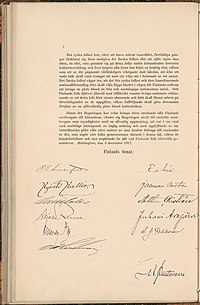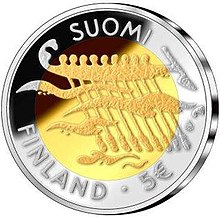 After several disagreements between the non-socialists and the social-democrats over who should have the power in Finland, on 4 December 1917, the Senate of Finland, led by Pehr Evind Svinhufvud, finally made a Declaration of Independence which was adopted by the Finnish parliament two days later.
After several disagreements between the non-socialists and the social-democrats over who should have the power in Finland, on 4 December 1917, the Senate of Finland, led by Pehr Evind Svinhufvud, finally made a Declaration of Independence which was adopted by the Finnish parliament two days later.Independence Day was first celebrated in 1917. However, during the first years of independence, 6 December in some parts of Finland was only a minor holiday compared to 16 May, the Whites' day of celebration for prevailing in the Finnish Civil War.
The left parties would have wanted to celebrate 15 November, because the people of Finland (represented by parliament) took power 15 November 1917. When a year had passed since declaration of independence, 6 December 1918, the academical people celebrated the day.
--------------------------------
The February and the October Revolution in 1917, had also ignited hopes in the Grand Duchy of Finland. After the abdication of Grand Duke Nicholas II on 15 March 1917, the personal union between Russia and Finland lost its legal base – at least according to the view in Helsinki. There were negotiations between the Russian Interim Government and Finnish authorities.
The resulting proposal, approved by the Interim Government, was heavily rewritten in the Parliament and transformed into the so-called Power Act (Finnish: Valtalaki, Swedish: Maktlagen), whereby the Parliament declared itself to now hold all powers of legislation, except with respect to foreign policy and military issues, and also that it could be dissolved only by itself. At the time of the vote it was believed that the Interim Government would be quickly defeated. The Interim Government survived, however, disapproved of the Power Act and dissolved the Parliament.
After new elections and the ultimate defeat of the Interim Government, on 5 November, the Parliament declared itself to be "the possessor of supreme State power" in Finland, based on Finland's Constitution, and more precisely on §38 of the old Instrument of Government of 1772, which had been enacted by the Estates after Gustav III's bloodless coup. This paragraph provided for the election of a new monarch in case of the extinction of the royal line and was interpreted in Finland as vesting sovereignty in the estates, later the Parliament, in such an interregnum.
On 15 November 1917, the Bolsheviks declared a general right of self-determination, including the right of complete secession, "for the Peoples of Russia". On the same day the Finnish Parliament issued a declaration by which it assumed, pro tempore, all powers of the Sovereign in Finland.
---------------------
English subtitles on these videos, and more found youtube, like parts 2 and 3
---------------------
Suomi itsenäistyi Venäjästä 6. joulukuuta 1917. Bolševikit olivat kaapanneet Venäjällä vallan lokakuun vallankumouksessa 7.–8. marraskuuta 1917, ja joulukuun 4. päivänä 1917 P. E. Svinhufvudin johtama senaatti antoi Suomen itsenäisyysjulistuksen. Eduskunta hyväksyi itsenäisyysjulistuksen joulukuun 6. päivänä äänin 100–88.
Itsenäisyyden alkuvaiheessa itsenäisyyspäivästä oli eri mielipiteitä. Oikeisto ajatteli, että Suomi irrottautui Venäjästä kokonaan vasta sisällissodan päätyttyä, ja halusi juhlia itsenäisyyttä valkoisen armeijan voitonparaatin päivänä 16. toukokuuta. Vasemmisto puolestaan ajoi itsenäisyyspäiväksi marraskuun 15. päivää, koska kansanvaltaa edustanut Suomen eduskunta oli julistautunut korkeimman vallan käyttäjäksi 15. marraskuuta 1917. Kun itsenäisyysjulistuksen hyväksymisestä oli kulunut vuosi 6. joulukuuta 1918, akateemiset piirit juhlistivat vuosipäivää.
Laajemmin joulukuun 6. päivää on vietetty itsenäisyyspäivänä vuodesta 1919 lähtien. Valtioneuvosto määräsi päivän tuolloin vapaapäiväksi valtion virastoissa, kouluissa ja tuomioistuimissa. Vuonna 1929 päivä säädettiin lailla yleiseksi palkalliseksi vapaapäiväksi.[4] Vuonna 1937 säädettiin laki itsenäisyyspäivän viettämisestä yleisenä juhla- ja vapaapäivänä. Sen mukaan itsenäisyyspäivän tuli olla palkallinen vapaapäivä tai siitä on maksettava korotettua palkkaa, kuten sunnuntaityöstä, jos ei ole mahdollista antaa vapaapäivää.
Itsenäisyyspäivä on virallinen liputuspäivä. Liputus päättyy muista talven liputuspäivistä poikkeavasti vasta klo 20
Civil war 1918
---------------------
The old Instrument of Government was however no longer deemed suitable. Leading circles had long held monarchism and hereditary nobility to be antiquated, and advocated a republican constitution for Finland.
The Senate of Finland, the government the Parliament had appointed in November, came back to the Parliament with a proposal for a new republican Instrument of Government on 4 December. The Declaration of Independence was technically given the form of a preamble of the proposition, and was intended to be agreed by the Parliament. Parliament adopted the Declaration on 6 December.
On 18 December (31 December N. S.) the Soviet Russian government issued a Decree, recognizing Finland's independence, and on 22 December (4 January 1918 N. S.) it was approved by the highest Soviet executive body, the All-Russian Central Executive Committee (VTsIK)
The Declaration and 15 November


Image of the Declaration in Swedish with the senators' signatures
With reference to the declaration of 15 November, the declaration says:
 The people of Finland have by this step taken their fate in their own hands; a step both justified and demanded by present conditions. The people of Finland feel deeply that they cannot fulfil their national and international duty without complete sovereignty.
The people of Finland have by this step taken their fate in their own hands; a step both justified and demanded by present conditions. The people of Finland feel deeply that they cannot fulfil their national and international duty without complete sovereignty. The century-old desire for freedom awaits fulfilment now; Finland's people step forward as a free nation among the other nations in the world. (...) The people of Finland dare to confidently await how other nations in the world recognize that with their full independence and freedom, the people of Finland can do their best in fulfilment of those purposes that will win them a place amongst civilized peoples.

90th Anniversary of Finland's Declaration of Independence commemorative coin.
--------
Estonia, Latvia, Lithuania declared their independence from Russia during the same period.
See Estonian War of Independence, Latvian Independence and Lithuanian Wars of Independence.
These three countries were occupied by, and annexed into, the Soviet Union (1940-1941, 1944-1991). See Occupation of the Baltic states.
Ei kommentteja:
Lähetä kommentti
Any explosive ammunition or empty cores, you can put in this.